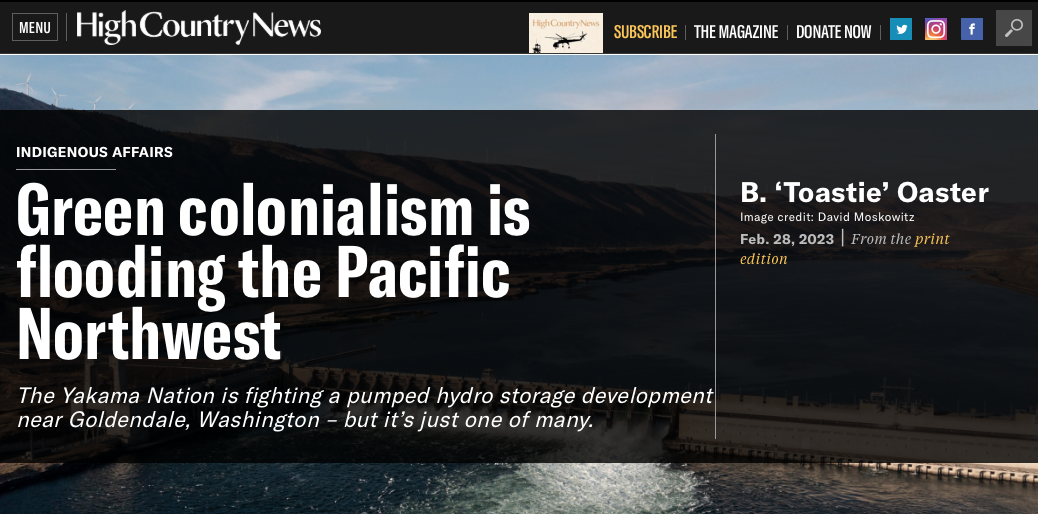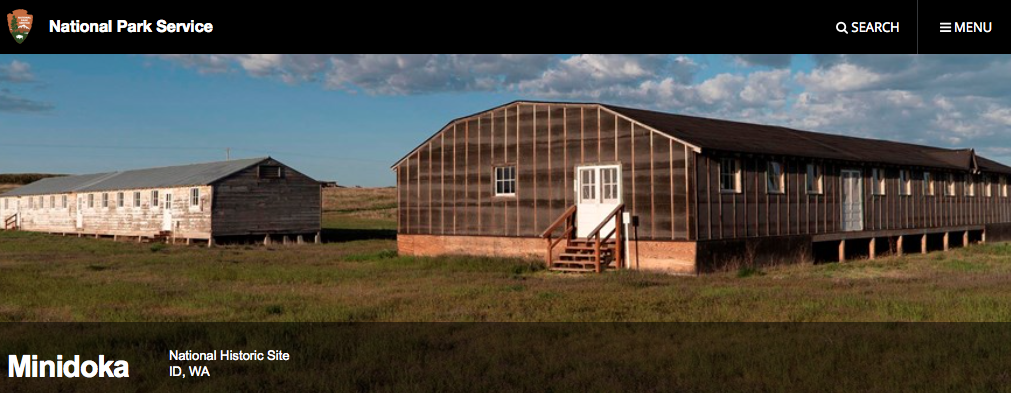March 8, 2023 - Good article by High Country News on the flood of renewable energy projects into the Pacific Northwest. See the article here>> https://www.hcn.org/issues/55.3/indigenous-affairs-green-colonialism-is-flooding-the-pacific-northwest?utm_source=wcn1&utm_medium=email&utm_campaign=2023-02-28-Newsletter
Equity is Being Ignored With Proposed Massive Wind Energy Project in Idaho
December 20, 2021 - Twin Falls, Id - This massive Idaho wind project is being pushed through by the Interior Department in spite of strong opposition from Japanese Americans. The Lava Ridge Wind Project in Idaho would be built next to the Minidoka National Historic Site, a World War II Japanese American incarceration camp. 400 gigantic wind turbine generators are proposed across 76,000 acres of mostly public lands lands, next to Craters of the Moon National Monument.
This is an old transmission corridor attracting new renewable energy projects, so the county gave the green light to build it. The region was unfortunately written off as a transmission and energy area a long time ago. The transmission corridor may predate the Minidoka National Historic Area. The 1980 Bureau of Land Management (BLM) Resource Management Plan (RMP) has an old Visual Resources class designation here, which should be updated to reflect the newer land designations of Minidoka National Historic Site and Craters of the Moon National Monument.
These corridors and energy zones were planned 10 or 20 years ago, but agencies and current administrations seem unable to update these designations when they significantly impact important cultural sites. Energy and transmission designations from years ago are not keeping updated with modern Equity concerns.
We are asking the Bureau of Land Management to slow down on this review and update their Resource Management Plan. This is not acceptable. BLM must review the RMP before approving Lava Ridge Wind Project.
Basin and Range Watch was very sensitive to proposed solar projects adjecant to the Manzanar National Historic Site and Japanese-American internment camp. We opposed these utility-scale energy projects that would ruin the visual resources of this important historic site in Owens Valley in a remote and desolate location. This gigantic wind energy project is similar, and we oppose it next to this significant cultural historic site.
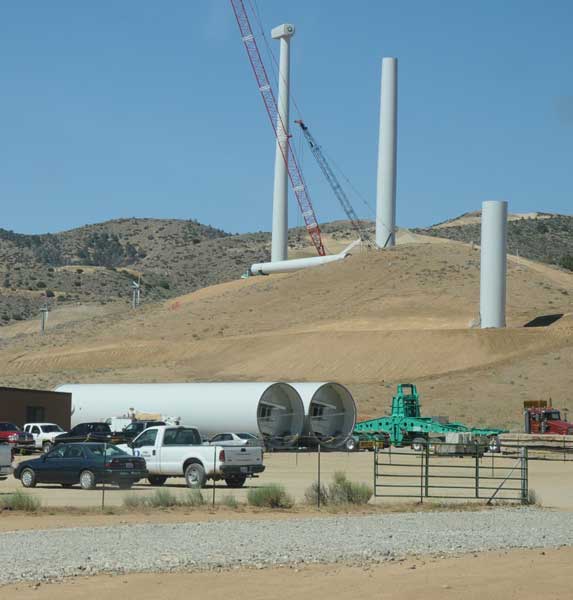
^Tehachapi wind project under construction. See more photos >>here.
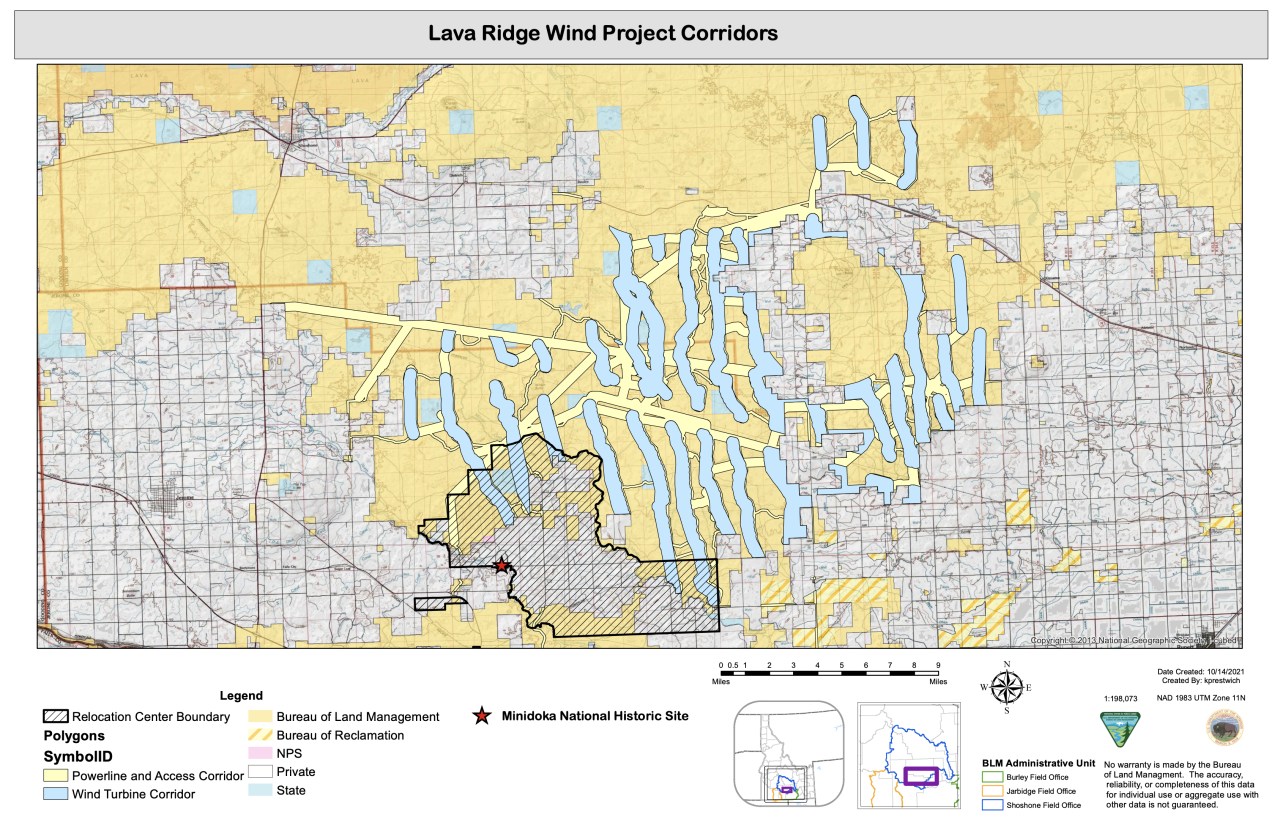
^Map showing wind project and transmission lines encroaching into the Minidoka relocation center boundary.
Japanese Internment Camp History Is Not Respected
The Minidoka National Historic Site, managed by the National Park Service, webpage states:
The Pearl Harbor attack intensified existing hostility towards Japanese Americans. As wartime hysteria mounted, President Roosevelt signed Executive Order 9066 forcing over 120,000 West Coast persons of Japanese ancestry (Nikkei) to leave their homes, jobs, and lives behind, forcing them into one of ten prison camps spread across the nation because of their ethnicity.
We have visited the Japanese American National Museum in Los Angeles, and understand that this difficult history should be appreciated, remembered, and the landscapes surrounding these sites respected.
When Will Renewable Energy Projects Locate Appropriately?
"Smart From The Start" siting of large-scale solar and wind projects is still touted by many environmental groups, yet after more than 10 years of observing and commenting on these projects, basin and Range Watch still does not see better siting of these huge utility-scale energy projects on public lands, with respect to cultural concerns, visual resources, rare species, and carbon-sequestering ecosystems.
Details of the project are copied below:
The BLM requests comments concerning the scope of the analysis and identification of relevant information, studies, and analyses. All comments must be received by September 20, 2021. The Draft EIS is scheduled for the summer of 2022 and the Final EIS is scheduled for late 2022 with a Record of Decision issued no sooner than 30 days after the Final EIS is released. The BLM will hold public scoping meetings; the dates, locations, and times will be announced at least 15 days in advance through public notices, media releases and/or mailings.
The BLM requests comments concerning the scope of the analysis and identification of relevant information, studies, and analyses. All comments must be received by September 20, 2021. The Draft EIS is scheduled for the summer of 2022 and the Final EIS is scheduled for late 2022 with a Record of Decision issued no sooner than 30 days after the Final EIS is released. The BLM will hold public scoping meetings; the dates, locations, and times will be announced at least 15 days in advance through public notices, media releases and/or mailings.
Send written comments to: Lava Ridge Wind Energy EIS, BLM Shoshone Field Office, Attn: Kasey Prestwich, 400 West F Street, Shoshone, ID 83352. Send comments via email to BLM_ID_LavaRidge@blm.gov. Submit comments online at https://go.usa.gov/xFKxg and click on the “Participate Now” button to the right of the document link. Enter your comment and information, then click “Submit”.
FOR FURTHER INFORMATION CONTACT:
Kasey Prestwich, Project Manager, BLM Shoshone Field Office, 400 West F Street, Shoshone, ID 83352, 208-732-7204, kprestwich@blm.gov. Persons who use a telecommunications device for the deaf (TDD) may call the Federal Relay Service (FRS) at 1-800-877-8339 to contact the above individual during normal business hours. The FRS is available 24 hours a day, seven days a week, to leave a message or question with the above individual. You will receive a reply during normal business hours.
SUPPLEMENTARY INFORMATION:
Purpose and Need for the Proposed Action
In Executive Order 14008, President Biden emphasized the need for the United States to “deploy the full capacity of its agencies to combat the climate crisis” in an approach that focuses attention on “innovation, commercialization, and deployment of clean energy technologies and infrastructure.” The Department of the Interior (DOI) has prioritized “identifying steps to accelerate responsible development of renewable energy on public lands and waters.”
Magic Valley Energy's, LLC (MVE) goal for Lava Ridge is to construct and operate a commercial-scale wind energy facility that reliably and economically produces wind energy for delivery to power markets in the western United States. This goal arises from regulatory, utility, and consumer-driven objectives to incorporate new renewable and carbon-free energy sources into energy supply portfolios. Substantial increases in new renewable energy are required to meet this need. Most western states have specific renewable energy goals. Based on the goals and objectives of the proponent and the BLM's authority, the BLM will evaluate the ROW grant application submitted by MVE in compliance with FLPMA, BLM regulations, and other applicable Federal laws and policies. The need for the BLM's action arises from FLPMA, which establishes a multiple use mandate for management of Federal lands, including “systems for generation, transmission, and distribution of electric energy” (FLPMA Title V). The BLM's action in considering MVE's ROW application is a delegated authority of the Secretary of the Interior to “grant issue or renew rights of way . . . for generation, Start Printed Page 46868transmission, and distribution of electric energy” (43 CFR part 2800).
Preliminary Proposed Action and Alternatives
As described in the plan of development (POD), MVE proposes to construct Lava Ridge which includes up to 400 wind turbines with a maximum height of up to 740 feet, up to seven new substations, a battery energy storage system, three operations and maintenance facilities and associated infrastructure. Associated infrastructure required by the project includes access roads, electric collector lines and transmission lines to interconnect the generated power to the electric grid.
The Draft EIS will analyze a reasonable range of alternatives to be fully developed after considering information provided during the scoping period. Preliminary alternatives may include changes to proposed facility layouts, activity schedules, and seasonal operation requirements designed to protect resources under BLM management while still retaining a reliable and economically feasible wind energy facility. The range of alternatives analyzed in the Draft EIS will include a no action alternative. Under the no action alternative, the BLM would deny the application, and MVE's wind energy facility described in the POD would not be built.
Summary of Expected Impacts
The Draft EIS will identify and describe the effects of the Proposed Action on the human environment. Based on a preliminary evaluation of resources, the BLM expects impacts (either beneficial or adverse and of varying intensity) to wildlife and their habitats, land uses, cultural resources, visual resources, and social and economic conditions.
Preliminary issues of concern to be analyzed in the EIS include, but are not limited to:
Short-term or long-term loss of wildlife habitat, including greater sage-grouse, and sensitive plant species due to ground disturbance;
Changes to visual character and scenic quality due to the development and operation of the proposed project;
Changes in access to and the quality and quantity of recreation and grazing resources for existing users;
Changes to social and economic conditions resulting from the development and operation of the proposed project; and
Physical, visual, and audible disturbance to historic properties and cultural properties within and outside of the project area.
Anticipated Permits and Authorizations
In addition to the requested ROW grant, other Federal, state, and local authorizations will be required for Lava Ridge. These include authorizations under the Bald and Golden Eagle Act, Clean Water Act, 14 CFR part 77, and other laws and regulations determined to be applicable to Lava Ridge.
Schedule for the Decision-Making Process
The BLM expects to issue a decision by early 2023. It is anticipated that MVE will secure all necessary authorizations following the BLM decision.
Public Scoping Process
This NOI initiates the scoping process, which guides development of the EIS. The scoping process encourages those who may be interested or affected by Lava Ridge to submit comments on resources and issues, impact-causing factors, reasonable alternatives and potential mitigation measures to be analyzed in the EIS. For information on how to submit comments, see the ADDRESSES section above. The BLM will hold public scoping meetings; the dates, locations, and times will be announced at least 15 days in advance through public notices, media releases and/or mailings.
The BLM will use the NEPA process to satisfy the public involvement requirements of Section 106 of the National Historic Preservation Act (NHPA) (54 U.S.C. 306108) pursuant to 36 CFR 800.2(d)(3). Information about historic and cultural resources within the area potentially affected by Lava Ridge will be used to identify and evaluate impacts in the context of both NEPA and Section 106 of the NHPA. Federal agencies, Tribes, State and local governments, and other stakeholders interested in historic properties and cultural resources may request to participate in the Section 106 process as a Consulting Party. The BLM will continue consultation with Tribes on a government-to-government basis in accordance with Executive Order 13175 and other policies. Tribal concerns, including potential impacts to cultural resources and treaty rights will be given due consideration.
Request for Identification of Potential Alternatives, Information, and Analyses Relevant to the Proposed Action
The BLM requests assistance with identifying potential alternatives to the Proposed Action. As alternatives should resolve a problem with the Proposed Action, please indicate the purpose of the suggested alternative. The BLM also requests the identification of potential impacts that should be analyzed. Impacts should be a result of the action; therefore, please identify the activity along with the potential impact. Information that reviewers have that would assist in the development of alternatives or analysis of resources issues is also helpful.
Lead and Cooperating Agencies
The BLM Shoshone Field Office is the lead agency for this EIS. The following have agreed to participate in the environmental analysis of the Project as Cooperating Agencies: National Park Service, U.S. Army Corps of Engineers, the State of Idaho, Jerome, Lincoln, and Minidoka Counties in Idaho.
Decision Maker
Field Manager, Shoshone Field Office.
Nature of Decision To Be Made
The BLM will decide whether to grant, grant with conditions, or deny the application for a ROW. Pursuant to 43 CFR 2805.10, if the BLM issues a grant, the BLM decision maker may include terms, conditions, and stipulations determined to be in the public interest.
Segregation of Lands
On April 30, 2013, the BLM published a Final Rule, Segregation of Lands—Renewable Energy (78 FR 25204), that amended the regulations found in 43 CFR 2090 and 2800. The provisions of the Final Rule allow the BLM to temporarily segregate public lands within a solar or wind application area from the operation of the public land laws, including the Mining Law of 1872, by publication of a Federal Register notice. The BLM uses this temporary segregation authority to preserve its ability to approve, approve with modifications, or deny proposed ROWs, and to facilitate the orderly administration of the public lands, subject to valid existing rights. Licenses, permits, cooperative agreements, or discretionary land use authorizations of a temporary nature which would not impact lands identified in this NOI may be allowed with the approval of an authorized officer of the BLM during the segregation period.
The comapny's information can be found here:
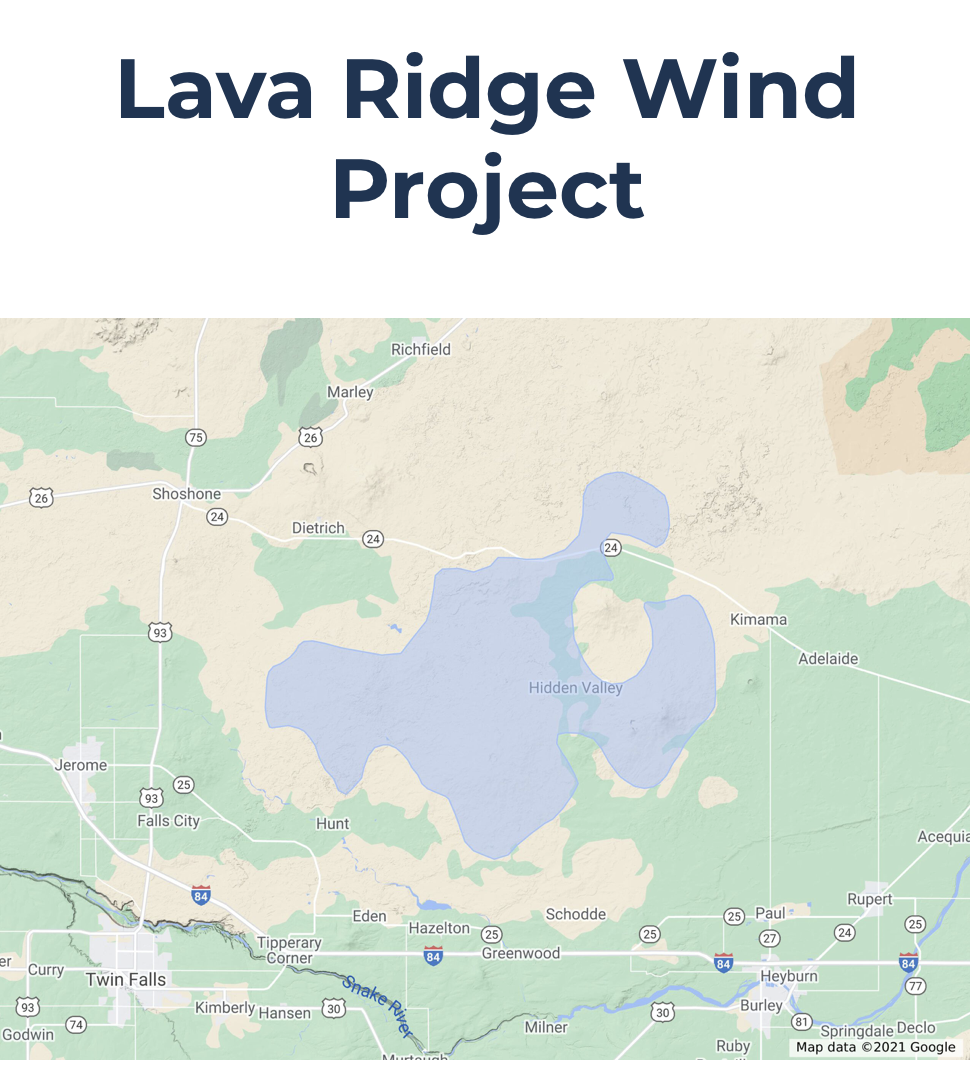
^Wind developer's map of the proposed project in Idaho.
From media:
https://www.kivitv.com/ksaw/lava-ridge-wind-project-faces-criticism
TWIN FALLS — A proposed wind turbine project is facing some opposition due to its proximity to the Minidoka National Historic Site. Now, advocates are speaking out to highlight why preserving the space is important for so many individuals.
740 feet tall high wind turbine towers (!)
If approved the turbines would be roughly one to two miles away from the Minidoka National Historic Site's visitor center.
For many Japanese Americans, especially those sent there, the site is very sacred ground. David Sakura's incarceration at Minidoka began in 1942, less than a year after the bombing of Pearl Harbor. He had not even finished kindergarten when, at the age of six, he and his family were removed from their small logging community in Eatonville, Washington. They were first taken to a detention camp in Seattle in May 1942 and then transported to Minidoka in September by train on a 35-hour journey.

Interior Department Announces Next Steps for Idaho Onshore Wind Energy Project
8/19/2021
Last edited 8/19/2021
Date: Thursday, August 19, 2021
Contact: Interior_Press@ios.doi.gov
WASHINGTON — The Department of the Interior announced today that the Bureau of Land Management (BLM) is seeking public input on a commercial-scale wind energy facility that is proposed to be constructed on BLM-managed public land in southern Idaho, approximately 25 miles northeast of Twin Falls. The Lava Ridge Wind Energy Project has the potential to generate 1,000 megawatts of wind energy.
“Renewable wind projects are a critical component of the Biden-Harris administration’s commitment to confronting climate change, promoting clean air and water for our current and future generations, creating thousands of good-paying union jobs, and jump starting our country’s transition to a clean energy future,” said Secretary Deb Haaland. “At the Interior Department, we are doing our part to ensure these projects are done thoughtfully and avoid impacts to surrounding communities. The Department is committed to public input and meaningful Tribal consultation to uphold our trust and treaty responsibilities.”
https://eplanning.blm.gov/eplanning-ui/project/2013782/510
Lava Ridge Wind Project Project Information
NEPA Number: DOI-BLM-ID-T030-2021-0015-EIS
Project Name: Lava Ridge Wind Project
Project Type: Environmental Impact Statement
Project Status: In Progress - Public Scoping
Lead Office: Shoshone FO
Last Updated: 09/21/2021, 06:31:19 MDT
Project Description
Magic Valley Energy, LLC (MVE) seeks authorization to use Federal lands to construct, operate, maintain, and decommission the Lava Ridge Wind Project. The proposed project is located primarily on public lands administered by the Bureau of Land Management (BLM) Shoshone Field Office, approximately 25 miles northeast of Twin Falls, Idaho, within Jerome, Lincoln, and Minidoka Counties. The project’s planned 500 kilovolt (kV) transmission line may interconnect at the existing Idaho Power Midpoint substation approximately 7 miles south of Shoshone, or at an alternative location inside the right-of-way corridor for the not yet constructed, Southwest Intertie Project – Northern Portion (SWIP-North). The proposed project includes up to 400 wind turbines, up to seven new substations, approximately 198 miles of 34.5 kilovolt (kV) collector lines, 34 miles of 230 kV transmission lines, 18 miles of 500 kV transmission lines, 381 miles of access roads, 47 miles of temporary crane paths, a battery energy storage system, three operations and maintenance facilities, five permanent met towers and construction-related staging yards. The project proposal has identified a range of possible turbine sizes that would have a generating capacity of 2 to 6 megawatts (MW) per turbine and would have heights ranging from 460 to 740 feet tall. MVE has proposed to locate all components of the project within a series of corridors. These corridors are approximately 1/2 mile wide and cover approximately 76,000 acres, of which 73,000 acres are located on public lands managed by BLM and 3,000 acres are State Lands managed by the Idaho Department of Lands. The project infrastructure proposed within the corridors is estimated to have a 10,000-acre footprint. If the proposed action or an action alternative is approved by the BLM, a final project design and layout with a specific footprint will be established utilizing detailed engineering requirements and required design criteria established within the EIS and Record of Decision. The total MW capacity will depend on the project's final design and layout, but the project is anticipated to have a generation capacity of 1,000 MW or more.
What's New
Bureau of Land Management extends public scoping period on proposed wind energy project
SHOSHONE, Idaho – The Bureau of Land Management is seeking public input on a commercial-scale wind energy facility that is proposed to be constructed on BLM-managed public land in southern Idaho, approximately 25 miles northeast of Twin Falls. Magic Valley Energy LLC, an affiliate of LS Power, is seeking authorization to construct the Lava Ridge Wind Energy Project on 73,000 acres of public land in Jerome, Lincoln and Minidoka counties. The project has the potential to generate 1,000 megawatts of wind energy.
Following two widely attended virtual public scoping meetings, the Shoshone Field Office plans to extend the public scoping period by 30 days, accepting public input until Oct. 20, 2021. According to Shoshone Field Manager Codie Martin, “It is critically important to us that we respond to the concerns that we heard during our initial public meetings. We want to provide enough time for all of the issues, potential impacts, alternatives, and mitigation measures to be brought forward,” he said. “We are still in the very early stage of the analysis process, so we would encourage those interested in this project to provide information they believe we need to consider.”
The proposed Lava Ridge Wind Energy Project includes up to 400 wind energy generating turbines, up to seven new substations, approximately 198 miles of 34.5 kilovolt (kV) collector lines, 34 miles of 230 kV transmission lines, 18 miles of 500 kV transmission lines, 381 miles of access roads, 47 miles of temporary crane walk paths, a battery energy storage system, three operations and maintenance facilities, five permanent meteorological towers, and construction-related staging yards. The proposed project’s planned 500 kV transmission line would interconnect at the existing Idaho Power Midpoint substation approximately seven miles south of Shoshone or at an alternative location along the permitted, but not yet constructed, Southwest Intertie Project – Northern Portion.
Comments can be submitted in the following ways:
Electronically via the BLM Land Use Planning and National Environmental Policy Act Register: Navigate to https://go.usa.gov/xFKxg and click on the “Participate Now” button to the right of the document link. Enter your comment and information, then click “Submit”
E-mail comments to BLM_ID_LavaRidge@blm.gov
Mail comments to Kasey Prestwich, Project Manager, BLM Shoshone Field Office, 400 West F Street, Shoshone, ID 83352
For more information contact Kasey Prestwich, Shoshone BLM Project Manager, at 208-732-7204, kprestwich@blm.gov, or see the Lava Ridge Wind Project BLM Land Use Planning and National Environmental Policy Act Register above.
Those who provide comments are advised that before including their address, phone number, e-mail address, or other personal identifying information, they should be aware that the entire comment – including personal identifying information – may be made publicly available at any time. While those commenting can ask in their comments to have their personal identifying information withheld from public review, the BLM cannot guarantee that they will be able to do so.
- BLM –
See also:
http://www.minidoka.org/lava-ridge
https://www.idahoconservation.org/blog/learning-more-about-the-lava-ridge-wind-project/
Cultural Landscapes Ignored
Across California, Nevada, and the Western U. S., we are witnessing that if Indigenous groups have signifciant sites and lands in the way of renewable energy, then they are swept aside in this push for utility-scale energy at all costs. Yet another example:
As Xcel electrifies the plains, how close is too close to the Sand Creek Massacre site?
https://coloradosun.com/2021/12/08/xcel-power-pathway-sand-creek-massacre-national-historic-site/
Many of these "green" projects encroach on sacred sites and places of historic significance. Yet many administrations continue to approve these large-scale energy projects regardless.
Home....Wind Project Impacts in the Tehachapi Mountains CA....Solar Projects denied near Manzanar National Historic Site
